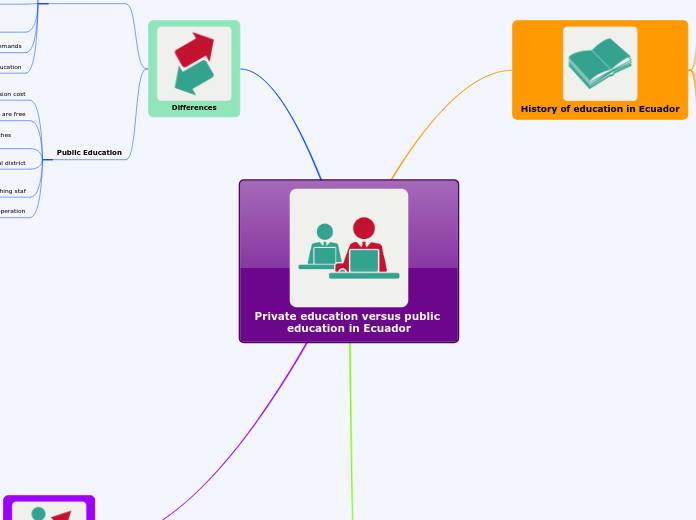
Private education versus public education in Ecuador

History of education in Ecuador
Most of the Constitutions in the Ecuadorian republican era have emphasized
Promote and encourage public education
To dictate general laws of education for all establishments of public instruction.
Teaching is free, with no more restrictions than those indicated in the laws
Education is a function of the State.
In 1835
Decree of the First Organic of Public Education
General Directorate of Studies and the Subdirectorates and Inspectories of Instruction were established
As of 1875
General Directorate became the General Council of Public Instruction
institution in charge of managing universities, colleges, high schools, and schools, in accordance with Catholic doctrine
In 1884
the Ministry of Public Instruction
the governing body of Ecuadorian education
In 1906
Organic Law of Public Instruction
public education will be imparted in national establishments maintained by the State
In 1938
Higher Education Law No. 10 was established
the universities the autonomy for their technical and administrative management
In 1946
Political Constitutions of the Ecuadorian
new criteria for the development of society and the world.
Today education in is regulated by the Ministry of Education.

Organization
Education in Ecuador is divided into
Fiscal
Municipal
Private
Secular or religious
Hispanic or intercultural
School activities are carried out in two regimes
Sierra - Amazon
Coast – Galapagos

Differences
Private Education
Paid education, tuition and pension cost governed by the ministry of education
Textbooks and uniforms must be purchased by each student
Hourly load according to the established curriculum, taking into account the optional subjects that each private educational institution can choose.
School day established by the authorities of each educational institution
Greater administrative demands
Personalized education
Public Education
Free education, no tuition or pension cost
Textbooks and uniforms are free
Hourly load in accordance with the curricular meshes established by the Ministry of Education
School day established by each educational district
Mass education
Higher remuneration for teaching staf
Minimum requirements for its operation

Levels
Initial education
It is divided into Initial 1 (from 3 years) and Initial 2 (from 4 years)
Its objective is to enhance learning through meaningful and timely experiences within a stimulating, healthy and safe environment.
The workspace should be divided into corners, with specific materials to promote meaningful play based on the interest of each child.
Basic general education
It is divided into
Basic Preparatory (sublevel 1)
corresponds to the 1st grade of Basic, 5-year-old children
Basic Elementary (sublevel 2)
corresponds to the 2nd, 3rd and 4th grades of Basic, children from 6 to 8 years old
Medium Basic (sublevel 3)
corresponds to the 5th, 6th and 7th grades of Basic, children from 9 to 11 years old
Basic Superior (sublevel 4)
corresponds to the 8th, 9th and 10th grades of Basic, preadolescents from 12 to 14 years old
Evaluation is permanent, systemic, and scientific. Seeks improvements in their training through encouragement
High school
Corresponds to the last 3 years of education
At the end of the 3rd year of Baccalaureate, the student obtains his bachelor’s degree.
Its objective is to provide general training and interdisciplinary preparation
It aims to develop learning capacities and citizenship skills.
